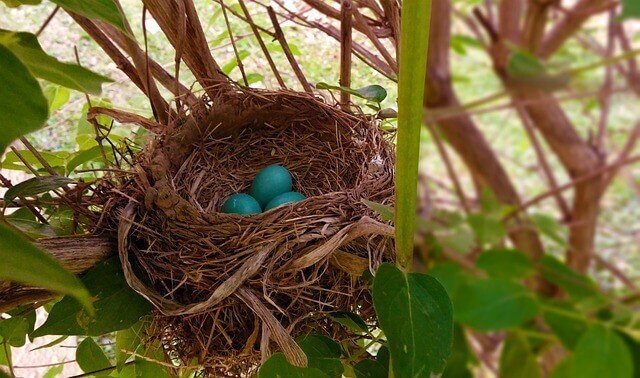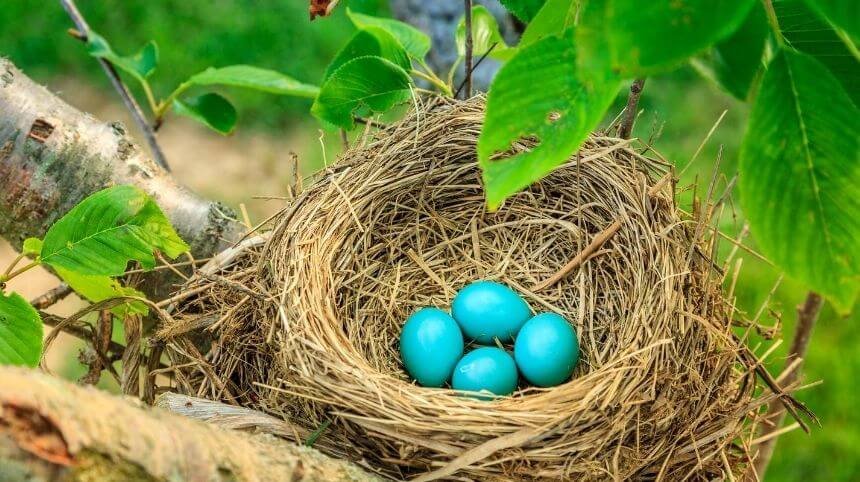Have you ever wondered why are robin eggs blue? Robin birds are slightly different from other birds. This is why many people are eager to learn more about them. The blue color of the robin eggs is mainly due to the presence of a particular pigment called biliverdin. Such pigments are not found in the eggs of other species of birds.
This is why their eggs are so special. So, let us discuss the about the nest building characteristics and other facts of this amazingly beautiful birds.
All about Robin Birds
Wherever you live in the United States, these birds are perhaps available and seen everywhere. They are also called as songbirds due to their sweet chirping sound. They are mainly seen during the spring season. Many of the Robin birds migrate towards the south during winter, while the others tend to stay in a particular place throughout the year.
The birds are in grayish brown color and possess a red fur covered tummy. The male Robins are pretty much attractive than the female bird. Their favorite meals are earthworms, and they die to capture them from the ground. Apart from earthworms, they also love to eat nuts, seeds, berries, and some common fruits.
Other than this Robin birds also have some fantastic facts –
- Juvenalian breeds of robin have a brown tummy rather than red, and they usually grow red feathers during their first molt.
- In the twentieth century, Robin birds were commonly referred to as red-breasted birds.
- Robin birds are a member of the thrush family, and so they slightly resemble characteristics of the blackbird and the nightingales.
- Both the female and the male are active and capture their territory during the winter season; these birds often sing the same song during the winter season.
- In the year 1960, Robin bird was declared as a national bird of Britain.

- The British postman used to wear red coats and so gained the nickname as robin due to their redbreast colored uniform.
- The birds are usually short-lived species, and they can maximum live around for eight years.
- Cats often killed many of the British Robins.
- Many of the Robin birds are often mistaken from nightingales due to their sweet sound.
- Each breed of Robin has a different color pattern, and distinguishing them is harder.
- Robin birds fall in the category of omnivorous species, which means they love to eat worms but can also live on fruits and vegetables.
- Do you know that many attempts were made to introduce robin birds to Australia, New Zealand, and America, but all such attempts were failed?
- Many of the male Robins often fight until death when the problems come regarding defending their territory.
- The British robins will never enter a regular round-shaped entrance nest boxes if you keep them as your pet. They usually prefer open boxes during their breeding season.
- In case you want to know which the favorite meal of robin birds is, they are perhaps the mealworms.
- The birds are usually shy in nature and do not easily get attached to humans.
So, these were some of the characteristics and tendencies of these fantastic birds. Now let us look at how they plan to give birth to their offspring during their breeding season.
Nest Building Activity of Robin Birds
Pairs of Robin bird bond in their breeding season. Females are mainly responsible for the nest-building process. Their nests are made in the same way as those of other birds that are with twigs, dry grass, and mud. You can even see some strings or ribbons in their nest as they might have found those from nearby. Some of the Robin nest may also have lichens and different types of moss collected from the trees.
Preferred Location :
As you have already known that why are robin eggs blue, you should also know some of the basics of their nests so that you can quickly identify them. They build bowl-shaped nests, and such nests are mainly found in bushes, trees, or eaves of some buildings that are at least 5 to 30 feet above the ground. As usual, they also build their nest in such a place where no one can disturb their process. Their nests are 4 to 6 inches in height and nearly 4 inches in diameter. You can imagine that their nest has size enough to keep a baseball in it.

For the nest to be successful, it should be strong enough to last for a month and capable of keeping 4 premature birds. The nest should also be capable of providing them the necessary heat insulation. The female bird sits on the nest for 13-14 days to keep the nest, and thus the eggs warm and dry.
They also tend to reuse the nest left by other robin birds by repairing them accordingly. The female makes a regular visit around the surrounding in finding such good quality abandoned nest. It takes nearly 2-3 days for her to complete its nest.
Robin Eggs :
Other than knowing why are robin eggs blue, you should also know some other facts about their eggs. In case you want to know about how many eggs do robin eggs lay, the bird typically lays 2-4 eggs at a time. The size and weight of their eggs are near a quarter. During the two weeks, the incubation period, both the parents share their responsibilities. But in case Robin eggs not hatching, they abandon them. The female may deliver 2-3 rounds of such nesting process. The young are generally born on the 14th day with their closed eyes similar to babies of other birds.

Protecting and Cleaning of the Eggs :
Both the parents of the Robin bird babies can get aggressive when it comes to saving their nest. They also can generate a series of alarm to warn their enemies. The females usually sit calmly inside the nest while the male try to divert their predators.
The nest is full of feeding and pooping of the Robin birds’ babies, but you must have seen why their nests are always clean in every stage. This is so because the parents regularly devote their extra time to the nest cleaning process and throw away the unwanted materials of the nest.
Some More Facts About Robin Birds and Robin Eggs
Do you know the fact the many birds lay their eggs during sunrise? But Robin birds lay their eggs at mid-morning, and that’s the time we usually have our breakfast or goes to the office. Robin birds eat a lot of earthworms during the mating season. Such worms are visible only when there is the presence of sunlight. So, the Robin bird feeds on them and then starts laying eggs and so they are 3-4 hours late than the other birds.
In case you think that laying eggs is an easy process, it is not true. A Robin bird actually lays one egg per day; this is because female birds have one active ovary while the mammals have two. You should know that ovaries are such an organ that is responsible for the development of the child.
Some Frequently Asked Questions (Faq’s) You May Have
If you are fond of Robin birds, these are some of the commonly asked questions with their answer that can help you to know the robin bird better.
Why are birds eggs blue?
It is the biliverdin pigment that makes the eggs of Robin blue.
How long does it generally take for the eggs of Robin bird to hatch?
The incubation period of the Robin eggs is roughly around 12-14 days. Such dates can be decided as to when the Robin bird lays its last eggs.
What colors go best with robin’s egg blue?
The eggs of Robin are amazingly soft, tranquil, and clean; they reflect a classic blue tone similar to shades of cyan.
What color are robin’s eggs?
The color of the Robin eggs is blue due to the presence of some special pigment that gets deposit on their eggshells. You should also know the fact that the deeper blue of the egg indicates a healthier female.
Do robins abandon their eggs?
Robin birds abandon their eggs only when they feel that their eggs will not hatch. Generally, they sit on their eggs for 14 days, and when they feel that there is no chance of success, they abandon their eggs.
Are Tiffany blue and robin egg blue the same?
Yes, the Tiffany blue is associated with the lighter shades of Robin blue eggs. The company uses the same color as their theme and promotes their bags and materials of the same color.
The Final Words
Finally. I hope that now you are well aware of the fact why are robin eggs blue. The birds are magnificent, and so are their eggs. The eggs have an excellent shade of blue color, and so it is admired by many people.
You may have also learned about their nest-building activities along with their robin egg size. You can find these birds anywhere around, or it is better to visit a bird sanctuary to know them in a nice way.















